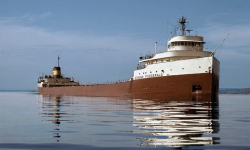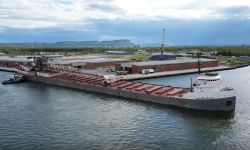Michigan approves $50M for Upper Peninsula copper mine — but with conditions

- The state will support a new copper mine near Lake Superior with $50 million in infrastructure funding
- The Michigan Strategic Fund board said concerns about the company’s funding had been resolved
- Still, the unanimous board vote came after dozens of comments from both supporters and detractors
The state of Michigan has agreed to spend $50 million to support a plan for a new copper mine near the shore of Lake Superior — despite disagreements on whether the economic benefits are worth the environmental risks.
After hearing dozens of speakers and two committee reports during the Michigan Strategic Fund meeting in Lansing, the board voted without comment to allocate $50 million toward the Copperwood mine planned by the Highland Copper Co. in the far western reaches of the Upper Peninsula about five hours west of the Mackinac Bridge.
Canada-based Highland Copper will only receive the money if it can prove that it has secured funding for the mine worth three times the state’s investment. The company’s overall investment is expected to be $425 million.
The project is among efforts “critical to emboldening Michigan's supply chain and creating jobs across the state,” Quentin Messer Jr., president and CEO of the Michigan Economic Development Corporation, told reporters during a media briefing on Tuesday.
Related:
- Michigan pauses $50M investment to bring back copper mining to Upper Peninsula
- Bipartisan vibes as Michigan lawmakers seek to reform SOAR incentive fund
- Gov. Whitmer’s SOAR incentive fund, once a triumph, now faces headwinds
“Construction of the Copperwood mine … will create hundreds of jobs in Gogebic County, while supplying copper material essential to the mobility and clean tech industries,” Messer said.
Opinions on the project grew over the past two months, after the mine funding proposal veered off course during an initial review by the board of the Strategic Fund, the public funding arm of the MEDC.
Board members raised questions about Highland Copper’s lack of funding for the project and whether the state was getting ahead of the mine’s marketability to investors. Questions also arose over the environmental impact of the project, particularly since the mine is projected to halt operations after about 11 years.
Messer said during the media briefing that all comments received during the two months between the initial meeting to discuss the project and Tuesday morning had been considered.
One driver for the decision to approve the project was what Messer described as the cost of inaction to Gogebic County, where the median income is $38,625, compared to $68,000 for the state. The county has just 14,000 residents and is among the smallest of Michigan’s 83 counties.
The project promises 380 new jobs paying $80,000 to $120,000, along with 300 construction jobs. State projections say it could result in $15 million in annual municipal and state tax revenue.
“We will continue to hear from all sides,” he said. “But we heard an overwhelming voice from across the U.P. … (that) implored us to try to support this because they realized that if it didn't, what it could do to those communities.”
Economic development officials and business leaders from across the U.P. agreed with Messer as they spoke during the public comment portion of the board meeting, which extended for nearly two hours.
Mary Beth DeFazio, president of the Lake Gogebic Area Chamber of Commerce and owner of AJ’s Lodge, said she’s witnessed economic decline professionally and personally.
“When mines left in the past, so did other businesses and so did jobs,” she said. “So did people, and it left us with a shell of a community.
“We need something to come in and build up our economy,” she continued. “The mine would bring more jobs into our town … and allow existing businesses to expand their hours and offer full- time year round employment.”
Environmental concerns
But many objections were voiced by the public, both people who live in the U.P. and others who watch the state’s environmental moves.
The mine operator wants to revive copper mining in a region that’s lost jobs and residents since the last major operation closed in the mid-1990s. Some speakers on Tuesday said that reviving a mine that will only operate for a little over a decade meant that Gogebic once again would be tied to a non-sustainable industry.
“The idea that this is a life-changing economic revitalization. We're talking barely a decade,” Tom Broadwell of Wakefield Township said.
“People say that this region is poor and that's why we need the mine. But mining is the reason this region is poor.”
Other speakers raised concerns about the toxic waste generated by copper mines, and they questioned whether safeguards promised by Highland Copper would truly protect Lake Superior and the Porcupine Mountains.
Al Gedicks, executive secretary of the Wisconsin Resources Protection Council, said waste will cover 360 acres of the mine area, and that it should be described as a permanent waste storage facility.
“The risks of a catastrophic … accident that would discharge toxic waste into Lake Superior are greatly increased with an underfunded exploration company that has every incentive to cut costs on the maintenance and repair,” he said.
The Michigan Department of Environment, Great Lakes, and Energy permitted the project in early 2023.
Michigan’s $50 million will come from the Strategic Outreach and Reserve (SOAR) fund’s Strategic Site Readiness Program, designed to use state funds to make large parcels of land development-ready.
That money is “imperative” for the project, according to MEDC staff reports on the project. Highland Copper anticipates $145 million in infrastructure improvements, including roads, water and wastewater systems and water quality analysis.
MEDC officials said many of the improvements will benefit the region, including access to stable utility service and roads to access the Porcupine Mountains.
Copper demand and EVs
The project was initially proposed in 2013, but shelved as copper prices plummeted. Now, demand is surging as the electric vehicle industry expands and the mineral was added to the federal list of critical minerals.
EVs require 2.5 times more of the metal than combustion engines, and a Bloomberg report estimates that demand for copper will surge 53% by 2040. The mine could generate $2.6 billion in mineral sales over 11 years, based on recent copper prices.
According to Tuesday’s vote, Highland Copper has until December 31, 2025, to show the state that it has at least $150 million in capital toward the project. That deadline, along with the company having to meet the funding milestone before the state will disburse money, was determined after review by the fund board’s five-member finance committee. Members are: Dimitrius Hutcherson, chair; state Treasurer Rachael Eubanks; Charles P. Rothstein; Leon Richardson and Randy Thelen.
Highland Copper [HI.V] stock was trading at about 10 cents per share on Tuesday. The company’s market capitalization was valued at $73 million.
Business Watch
Covering the intersection of business and policy, and informing Michigan employers and workers on the long road back from coronavirus.
- About Business Watch
- Subscribe
- Share tips and questions with Bridge Business Editor Paula Gardner
Thanks to our Business Watch sponsors.
Support Bridge's nonprofit civic journalism. Donate today.
See what new members are saying about why they donated to Bridge Michigan:
- “In order for this information to be accurate and unbiased it must be underwritten by its readers, not by special interests.” - Larry S.
- “Not many other media sources report on the topics Bridge does.” - Susan B.
- “Your journalism is outstanding and rare these days.” - Mark S.
If you want to ensure the future of nonpartisan, nonprofit Michigan journalism, please become a member today. You, too, will be asked why you donated and maybe we'll feature your quote next time!




